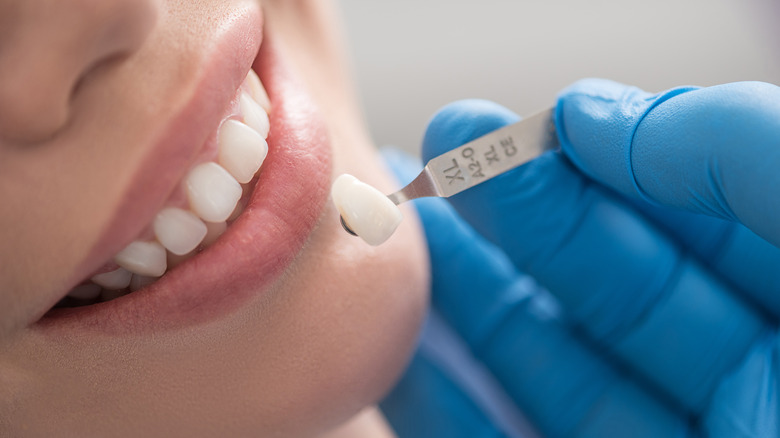What Happens To Your Teeth When You Get A Dental Crown
Getting dental work done is not usually at the top of anyone's list of ideal ways to spend a free morning. And true, if you miss a semi-annual cleaning, chances are you'll make it through to the next one intact (if you practice good oral hygiene in the meantime). But if you need a dental crown, putting it off is a bad idea. It can easily lead to more serious problems, including infection and tooth pain, down the road.
When dentists recommend getting a crown, they normally have good reasons for doing so. Crowns cover the whole visible surface of the tooth, and are used to protect teeth that have had root canals or are experiencing damage or decay. They can also be used for cosmetic reasons, like discoloration (via Verywell Health).
Actually getting a crown normally includes two separate appointments. At the first appointment, the dentist will examine and take an x-ray of the damaged tooth and surrounding bone structure, numb the area, and carefully file down very precise amounts of the tooth to prepare it for crowning (via Colgate).
Dental crowns can be restorative or cosmetic
Next, he or she will take an impression of the tooth, as well as the teeth on the opposite arch. Then, the impressions will be sent to a lab, where the crown is custom-made, allowing for a precise fit and color match. A temporary crown is set on the damaged tooth as a placeholder.
At the second appointment, the temporary crown is removed, and the tooth is cleaned and completely dried. The color, shape, and fit of the new crown is checked, and then it is cemented into place (via Colgate).
More recent developments in dental technology now also allow for same-day crowns. In that case, a scanning device takes detailed images of the tooth, which is then made into a 3D digital model. The information is then sent to a 3D printer, which produces a custom-made ceramic crown in about 15 minutes. Dr. Stephen Pitt, a dentist in Colchester, England, told Real Self, "The whole CEREC procedure, from start to finish, takes just 70 to 80 minutes—and 20 minutes of this is relaxing and drinking tea or coffee in the waiting room."
There are pros and cons to both types of procedures, so discuss all the options with your dentist before deciding which is best for you.


